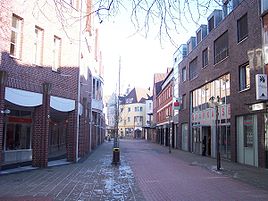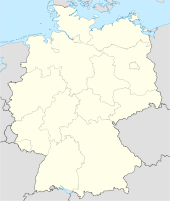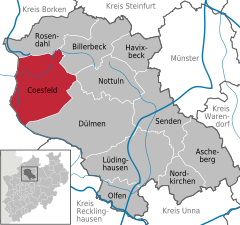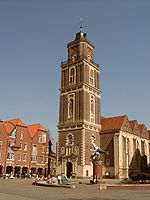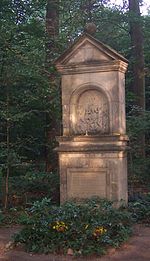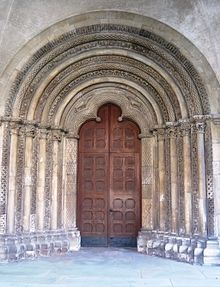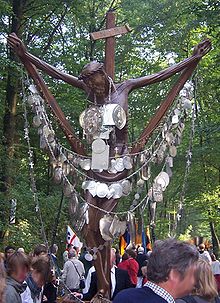- Coesfeld
-
Coesfeld 
Coordinates 51°56′45″N 7°10′3″E / 51.94583°N 7.1675°ECoordinates: 51°56′45″N 7°10′3″E / 51.94583°N 7.1675°E Administration Country Germany State North Rhine-Westphalia Admin. region Münster District Coesfeld Town subdivisions 2 Mayor Heinz Öhmann (CDU) Basic statistics Area 141.05 km2 (54.46 sq mi) Elevation 89 m (292 ft) Population 36,345 (31 December 2010)[1] - Density 258 /km2 (667 /sq mi) Other information Time zone CET/CEST (UTC+1/+2) Licence plate COE Postal code 48653 Area code 02541 Website www.coesfeld.de Coesfeld (German pronunciation: [ˈkoːsfɛlt]) is the capital of the district of Coesfeld in the German state of North Rhine-Westphalia.
Contents
History
Coesfeld received its city rights in 1197, but was first recorded earlier than that in the biography of St. Ludger, patron and first bishop of the diocese of Munster who was born north of Coesfeld in Billerbeck. The day before he died, Ludger spent the night in Coesfeld and heard mass in the morning in the church he founded. He was on his way from his abbey in Essen to Münster. The road he followed passed Coesfeld and Billerbeck, and after preaching in the St. Lambert's church, 26 March 809, he travelled on to Billerbeck, where he died in the evening.
The Coesfeld St. Jacobikirche dates from the same period as the city charter. For centuries, Coesfeld was an important stopping place for pilgrims traveling one of the more popular Germanic Jakobi routes (Way of St. James) leading from Warendorf over Munster (via Billerbeck) to Coesfeld, and then on via Borkum to Wesel on the Rhine.
Bernhard von Galen
During the Thirty Years War, troops were stationed in Coesfelf. The Prince-bishop of Münster was often at odds with these troops. Bernhard von Galen managed to drive the foreign troops away and even started to build a palace in Coesfeld, but it was never finished and after he died it was torn down. He became known for his sieges of Dutch cities in his efforts for the counter reformation and started a Way of the Cross procession that still exists up to the preset day, with 18 stations of the cross around the city. This procession was held for centuries on Whit Tuesday but is now held on Whit Sunday.
Geography
Coesfeld is situated in the Baumberge in Münsterland.
Neighbouring municipalities
Divisions
Coesfeld consists of 2 subdivisions:
- Coesfeld
- Lette
Education
Major secondary schools are the Nepomucenum, the Heriburg-Gymnasium and the St.-Pius-Gymnasium.
Persons of interest
- Hermann Wedekind († 1998), artistic director
- Anne Catherine Emmerich, Roman Catholic nun, visionary and stigmatic
- Rudolf Wolters (1903-1983), architect and associate of Albert Speer.
References
- ^ "Amtliche Bevölkerungszahlen" (in German). Landesbetrieb Information und Technik NRW. 31 December 2010. http://www.it.nrw.de/statistik/a/daten/amtlichebevoelkerungszahlen/index.html.
External links
 Media related to Coesfeld at Wikimedia Commons
Media related to Coesfeld at Wikimedia Commons Chisholm, Hugh, ed (1911). "Koesfeld". Encyclopædia Britannica (11th ed.). Cambridge University Press.
Chisholm, Hugh, ed (1911). "Koesfeld". Encyclopædia Britannica (11th ed.). Cambridge University Press.- (German) Official site
Ascheberg | Billerbeck | Coesfeld | Dülmen | Havixbeck | Lüdinghausen | Nordkirchen | Nottuln | Olfen | Rosendahl | SendenCategories:- Towns in North Rhine-Westphalia
- Coesfeld
- North Rhine-Westphalia geography stubs
Wikimedia Foundation. 2010.

